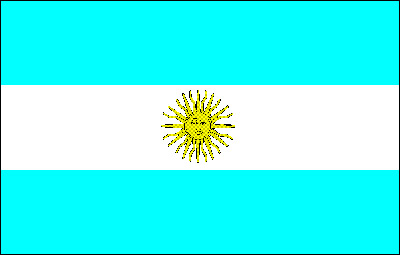Introduction: La ropa
Argentina's flag is significant to the history of the country. The blue and white stripes represent the blue sky and white clouds. The May sun in the middle of the flag was added to the flag later and is representative of the nation's independence day which is May 25, 1810. |
Having borders with the Andes mountains on the west and the Atlantic Ocean on the east, Argentina is a land of great diversity. There are pampas in the north of the country and flat to rolling plateaus in the province called Patagonia. Argentina is South America's second largest country and is home to more than 45,000,000 people. The majority of the Argentine people are of Spanish or Italian descent.
Argentina won its independence from Spain in 1816 and saw periods of conflict between different political and civilian groups within the country. In their more recent history, after World War II, the country was under the authoritative rule of Juan Perón. Perón did seem to help the oppressed of the country but unfortunately his social reforms were not long term. Perón was also very well known and remembered for his wife, María Eva Duarte, whom most referred to as Evita. She was a woman who sought to help those in need and was a spokeswoman for women's rights. Many of her followers wanted her to become vice-president of the country, but the military would not have it. Evita died of cancer in 1952 and her husband's popularity waned until 1955 when the military removed him from power.
Perón's political hold on Argentina did not end there. In 1973, Perón returned to Argentina from Spain, and was again elected president of the country. Isabel, his wife at this time, was his vice-president. Perón was president this second time from 1973 until he died in July of 1974.
From 1982 to 1983, Argentina transitioned to a full- scale democracy. Now Argentina has a president, legislative branch, and judicial branch. A president can serve a four-year term and is elected by the popular vote.


